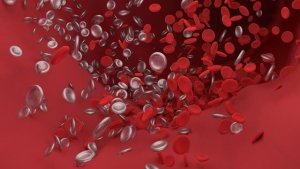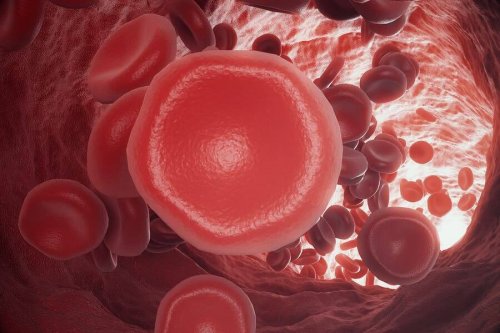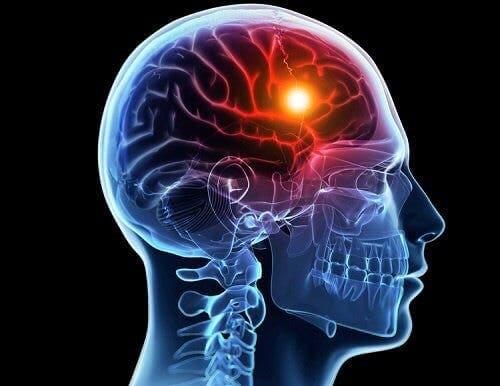Cerebral Embolism: What Is it and How Does it Affect Us?


Written and verified by the doctor Elisa Martin Cano
Cerebral embolism is a type of cerebral infarction. In other words, it’s a stroke that interrupts blood flow to a part of the brain. Unfortunately, it’s a very common pathology and an emergency situation. Here, we tell you everything you should know about it.
What’s a cerebral embolism?
As we already mentioned, a cerebral embolism is a type of cerebral infarction or stroke. This means that, due to the interruption of blood flow in a blood vessel of the brain, the area of the brain that was irrigated by that vessel doesn’t get the blood it needs.
When a tissue stops receiving blood, it also doesn’t get oxygen or other nutrients, since the blood is in charge of transporting these substances. What happens is that the cells that are part of that tissue first have a harder time performing their functions and, finally, end up dying.
The different types of strokes are based on the cause. Thus, a cerebral embolism is produced, as its name indicates, by an embolus that reaches a blood vessel in the brain.
This embolus can consist of different substances, such as a clot of cells and blood particles. The embolus travels through the vessels until it reaches one in which, due to its size, becomes blocked, preventing normal blood flow.

Causes and types of cerebral embolism
We discussed that an embolus can be formed by different substances. Thus, some of the main types of blood emboli and their causes are:
- Clots. Formed by a blood clot that acquires a denser consistency than normal blood. Its main cause is atrial fibrillation, which causes turbulent blood flow to the heart, which then leads to clots. Long immobilization, especially of the legs, after an operation or accident, can also lead to this condition.
- Air. An air bubble that prevents the passage of blood. It’s formed when air manages to get inside a blood vessel. For example, when a medical professional inserts a needle to draw blood.
- Fat. They’re produced when a lot of fats accumulate in the blood in the form of cholesterol.
For clarification purposes, we should note that the difference between a thrombus and an embolus is that a thrombus occludes the vessel in the same place in which it forms, without detaching from the walls. However, an embolus travels through the circulatory system until it becomes stuck. Therefore, the causes and types of thrombus and embolus are the same in origin.
Read on to learn more: Nine Foods that May Help Reduce Your Risk of Thrombosis and Stroke
How does it affect the body and what are its symptoms?
The brain is the organ in our body that’s most sensitive to blood flow. This is because it’s made up of many cells, neurons, that constantly require a lot of oxygen. The interruption of blood flow in an area causes brain tissue to atrophy and die within a few minutes.
Symptoms of a cerebral embolism manifest suddenly. Also, there are cases in which they gradually manifest in hours. However, this is uncommon.
The symptoms will depend on the blood vessel it affects and the area and extension of the brain they transport blood to. Some of the most common symptoms of cerebral embolism are:
- Headache
- Weakness or loss of feeling in one or more extremities or of one half of the body
- Sudden trouble speaking or understanding
- Uncoordinated movement when walking
- Dizziness or vertigo
- Vision loss in one or both eyes
This article may interest you: 8 Warnings From Your Body Before A Cerebral Stroke
Diagnosis and treatment

Cerebral embolism is an emergency situation. This is because the longer a brain area goes without irrigation, the more tissue will die, and the consequences will be more serious and irreversible. Thus, this condition requires a rapid recognition of symptoms and calling emergency services.
Once the emergency services have been called, the health workers are in charge of evaluating the patient’s condition. If necessary, medical professionals will request tests, such as a CT scan, to confirm that it’s a stroke and to classify it into one of the different types.
Once the doctor establishes the type of cerebral ischemia, the speed they treat it at will be essential. A cerebral embolism can be treated with drugs that dissolve the embolus or with surgery to remove it. This will depend on the type of embolus and its location. Thus, specialists decide the treatment that best suits each case.
Cerebral embolism is an emergency
It’s a common pathology and an emergency situation. Thus, it’s essential to recognize the symptoms and warning signs to notify emergency services. Then, they’ll decide the most appropriate steps to follow.
You must bear in mind that a person won’t always be able to recover all the functions they lost after suffering a stroke. This condition requires rehabilitation, whose duration will depend on each particular case.
All cited sources were thoroughly reviewed by our team to ensure their quality, reliability, currency, and validity. The bibliography of this article was considered reliable and of academic or scientific accuracy.
- Cabrerizo-García JL, Zalba-Etayo B, Martín-Villen L. Embolismo gaseoso arterial cerebral y coronario. Vol. 138, Revista Medica de Chile. Sociedad Medica de Santiago; 2010. p. 1461–2.
- Actualidades en prevención secundaria de infarto cerebral por fibrilación auricular [Internet]. [cited 2020 Apr 11]. Available from: https://www.medigraphic.com/cgi-bin/new/resumen.cgi?IDARTICULO=35550
- Revista Medicina – Google Libros [Internet]. [cited 2020 Apr 11]. Available from: https://books.google.es/books?hl=es&lr=&id=jIHzwkqXDhIC&oi=fnd&pg=PA202&dq=embolia+cerebral&ots=d-dWbKWHhR&sig=i10vOCBY-DMUarKdv6H7ScHtxM8#v=onepage&q=embolia cerebral&f=false
This text is provided for informational purposes only and does not replace consultation with a professional. If in doubt, consult your specialist.








